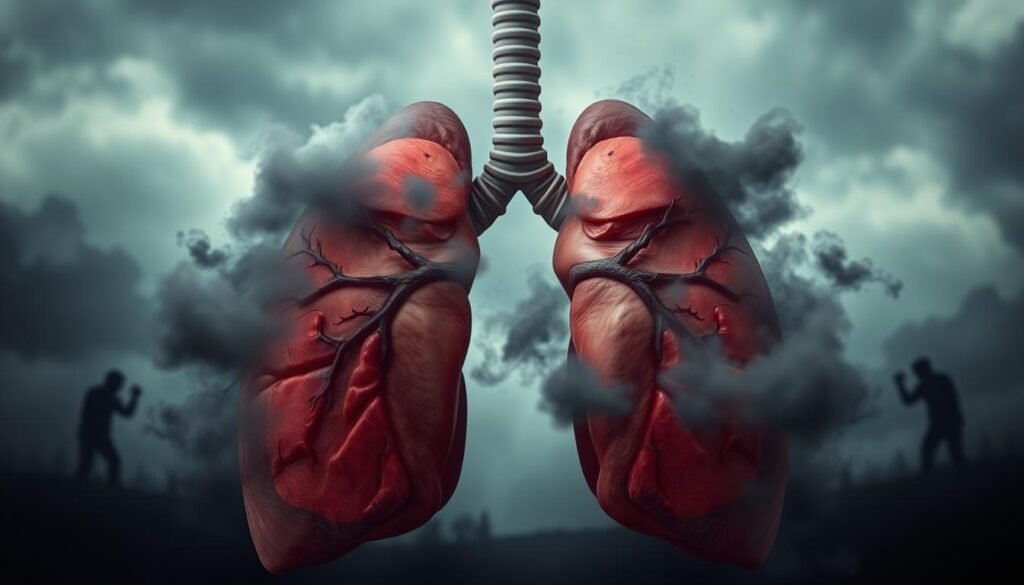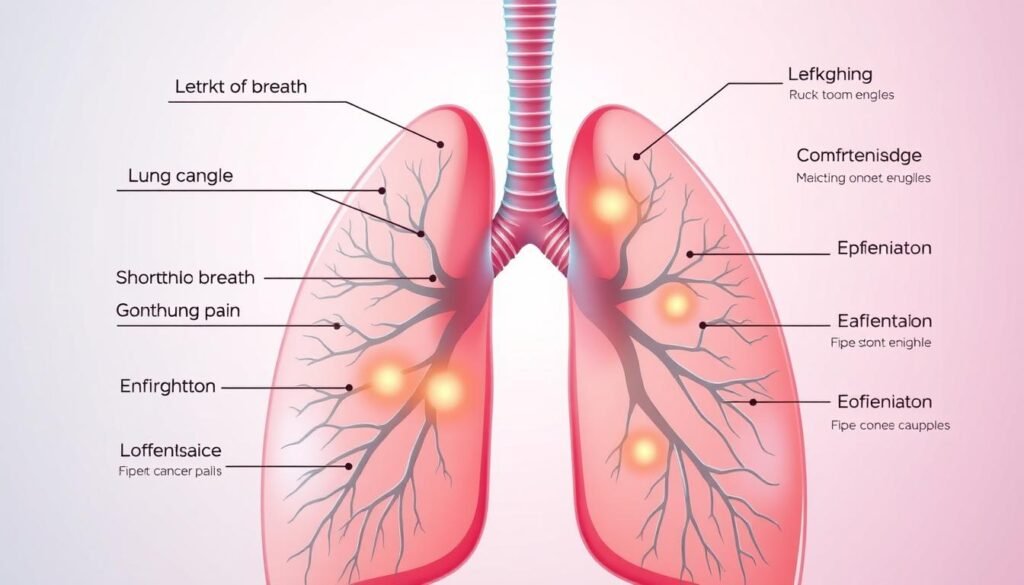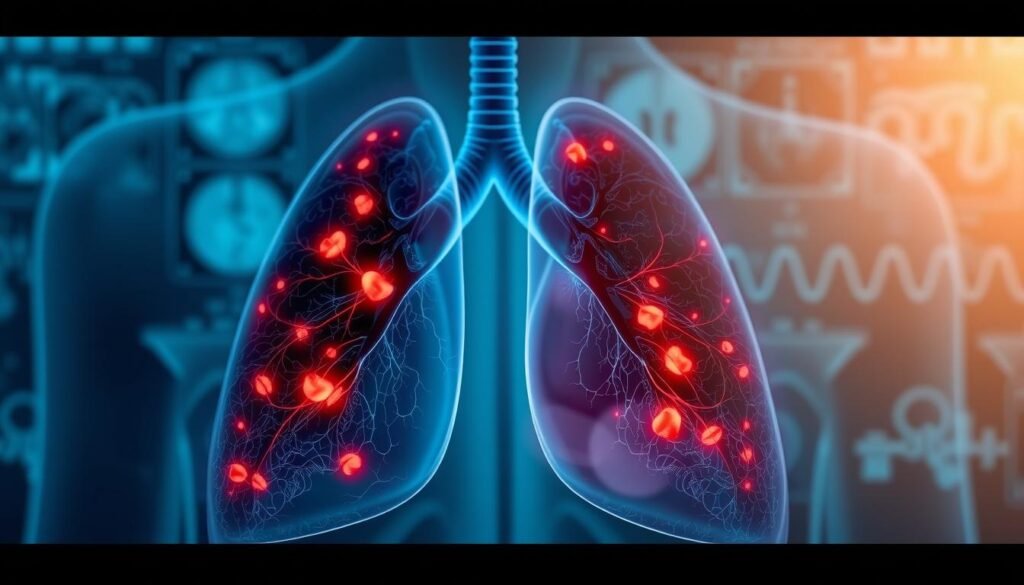Did you know that lung cancer is the top reason for cancer deaths around the world? It causes about 1 in 5 cancer deaths. This shows why it’s so important to know the symptoms of lung cancer. Knowing these can help spot the disease early. Usually, lung cancer doesn’t show symptoms at the beginning. This means it’s often not found until it’s more advanced. In this article, we’ll look at the key signs of lung cancer, explain why they’re important, and talk about how finding the disease early can lead to better health outcomes.
Key Takeaways
- Lung cancer is the leading cause of cancer deaths globally.
- Most lung cancers do not cause symptoms until they spread.
- Early diagnosis of lung cancer symptoms can lead to more effective treatment.
- Common symptoms include persistent cough, chest pain, and shortness of breath.
- Quitting smoking significantly reduces the risk of developing lung cancer.
- Many lung cancer symptoms may mimic other health conditions.
Understanding Lung Cancer Symptoms
Knowing the signs of lung cancer can greatly improve early detection and treatment. Lung cancer shows up differently in everyone. This makes it hard to identify key signs. About 75% of lung cancer cases are diagnosed late. So, it’s key for people at risk, like smokers, to know these symptoms well.
As lung cancer grows, certain symptoms appear. Persistent coughing, chest pain, and breathing trouble can signal lung cancer. Knowing these can lead someone to get help early. This improves the chance of successful treatment. For more details, check out this informative source.
Lung cancer symptoms can be similar to other breathing issues. This makes diagnosing harder. If you smoke or are around harmful substances a lot, watch for changes. Knowing your family’s health history and gene changes can help catch symptoms sooner.
| Risk Factor | Impact on Lung Cancer Risk |
|---|---|
| Tobacco Use | 85% of lung cancer cases |
| Secondhand Smoke | Responsible for 25% of cases in non-smokers |
| Family History | Increased susceptibility |
| Occupational Hazards | Exposure to carcinogens (e.g., asbestos) |
Statistics show that men have a 1 in 15 chance, and women a 1 in 17 chance, of getting lung cancer. This means understanding the symptoms is crucial for early detection.
Common Symptoms of Lung Cancer
Knowing the common signs of lung cancer is key for catching it early. Watching out for these symptoms can help get the right treatment in time. A lung cancer symptoms checklist can be really helpful in knowing what to look for. It’s an important step in fighting lung cancer.
A cough that persists
If you have a cough that doesn’t go away and gets worse, it might be lung cancer. This isn’t like a regular cough from a cold. It’s serious and happens a lot. If you see this happening, it’s a good idea to talk to a doctor.
Chest pain and discomfort
Chest pain can be a big warning sign, especially with deep breaths or coughing. Don’t ignore this pain. It could mean lung cancer or another serious problem.
Shortness of breath and wheezing
Feeling short of breath or wheezing is also a sign of lung cancer. This can happen if your lungs aren’t working right. It’s very important to see a doctor if breathing feels hard.
Coughing up blood or rusty sputum
If you cough up blood or something that looks like rust, it’s a red flag. This isn’t just about lung cancer, but also other big health issues. Treat it as an urgent matter.

To really understand these signs, check out the lung cancer symptoms checklist. It outlines different symptoms for various stages of lung cancer. This includes signs for both non-small cell and small cell lung cancer. It can give you a clear picture of what to look out for.
| Symptom | Description |
|---|---|
| Persistent Cough | Chronic cough that worsens over time. |
| Chest Pain | Discomfort felt in the chest area during breathing or coughing. |
| Shortness of Breath | Difficulty in breathing, often with wheezing. |
| Coughing Up Blood | Presence of blood in mucus or sputum. |
Early Warning Signs of Lung Cancer
It’s key to recognize early signs of lung cancer for better treatment results. Symptoms like unexplained weight loss, reduced hunger, and frequent lung infections are crucial. These lung cancer signs must not be ignored and prompt a doctor’s visit.
Unexplained weight loss
When you lose weight suddenly without trying, it could mean a health problem, like lung cancer. This might happen because the cancer affects your body’s energy use. Seeing a doctor is crucial if there’s no obvious cause for the weight loss.
Loss of appetite
Losing your appetite might also hint at lung cancer. Things like hypercalcemia in cancer patients can change how things taste. This can lead to eating less. Pay attention to this symptom, as it may signal something serious.
Frequent infections like bronchitis or pneumonia
Don’t overlook repeated lung infections, such as bronchitis or pneumonia. They could suggest lung issues, including cancer. Noticing these signs early can help with quicker diagnosis and treatment. For detailed info on lung cancer signs, see this resource.
Comprehensive Lung Cancer Symptoms
It’s vital to know the wide range of lung cancer symptoms for early detection. Some symptoms might not seem big at first. But they could show that the disease is getting worse. A checklist for lung cancer includes many physical signs that need attention.
General fatigue and weakness
People with lung cancer often feel very tired and weak. This tiredness can make doing everyday things hard. It comes with a lack of energy that rest doesn’t fix. These signs can mean more than just feeling tired all the time. They show the importance of checking out chronic fatigue.
Hoarseness and voice changes
Having a hoarse voice is a common lung cancer symptom. It can happen if a tumor presses on the vocal cords. This change in voice can be scary and shouldn’t be ignored. People might notice their voices sound different or weaker. This is why voice changes are key in finding lung cancer.

Detecting Lung Cancer Symptoms
Spotting lung cancer signs early is key to successful treatment. It’s important to regularly check in with your health. Know when to consult a doctor for lung cancer signs. Look out for ongoing problems. Symptoms like a steady cough, pain in the chest, or blood when coughing are serious.
Getting these symptoms checked early can greatly improve your treatment choices. It also boosts your chances of survival.
When to see a doctor
If you notice any of these, see a doctor right away:
- Persistent cough lasting longer than three weeks.
- Chest pain that gets worse when you breathe deeply or cough.
- Unexplained weight loss or not feeling hungry.
- Coughing up blood or rust-colored spit.
- Feeling short of breath or wheezing.
Importance of early diagnosis
Diagnosing lung cancer early can greatly help in treatment. Lung cancer doesn’t show symptoms in its early stages, so being aware is key. Finding it early opens up many treatment paths. These include surgery, chemo, and new therapies.
Low-dose CT scans work well for those at high risk. This group often includes people over 50 or those who have smoked for a long time. Early detection of lung cancer symptoms can lead to a much better outcome. It can improve life quality with the right treatment.

Advanced Lung Cancer Symptoms
As lung cancer gets worse, it shows signs that point to a serious stage. It’s key to spot these signs early for medical help. They include symptoms seen when the cancer has spread.
Pain and discomfort due to metastasis
Pain and discomfort can affect many areas as cancer spreads. This pain can be constant, impacting daily life. It shows how crucial effective pain management is. Knowing about this pain helps in finding the right treatments and options.
Neurological changes associated with spread
Cancer spreading can also change brain functions. Signs include confusion, headaches, or seizures. When cancer hits the brain or spinal cord, it affects how we think and move. Catching these signs early can help manage them, improving life quality.
Swelling in the face or neck due to lymph node involvement
Severe symptoms include swelling in the face or neck. This happens when tumors press on lymph nodes. Such swelling is serious and calls for quick checks to find the cause.
Lung Cancer Symptoms Related to Specific Types
It’s key to know the symptoms of lung cancer for prompt and correct diagnosis and treatment. This is especially true when telling apart small cell from non-small cell lung cancer. Each type shows different signs and treatment needs.
Differences between small cell and non-small cell lung cancer
Small cell lung cancer (SCLC) is quick to spread and usually linked to smoking heavily. People often see symptoms like a bad cough and losing weight quickly. On the other hand, non-small cell lung cancer (NSCLC) grows slower. Its symptoms, such as a long-lasting cough, chest pain, and trouble breathing, can slowly start to show. Knowing the symptoms and treatment for each type is crucial for patient care.
Small cell lung cancer can also lead to paraneoplastic syndromes. These can cause symptoms in different body parts, away from the main tumor. These might include changes in the brain and hormone levels. Meanwhile, non-small cell lung cancer often shows symptoms that are more focused in one area.
Understanding these differences helps both patients and doctors. It allows for faster treatment that can greatly improve quality of life.
Lung Cancer Symptoms and Treatment Options
Lung cancer symptoms depend on the disease type and stage. It’s vital to know these symptoms to find effective treatments. Treatments focus not just on fighting cancer, but also easing symptoms experienced during the illness. This dual focus helps create a care plan that addresses both the disease and the patient’s comfort.
Understanding treatment based on symptoms
Treatment for lung cancer varies based on the symptoms a patient has. Common options are surgery, radiation therapy, and chemotherapy. These methods aim to reduce or remove tumors. This can help ease symptoms like breathlessness or chest discomfort. In advanced stages, the goal may shift towards palliative care. This care improves life quality by managing symptoms and side effects.
Managing symptoms during treatment
During treatment, symptom management is key to comfort and well-being. Healthcare providers might prescribe medicine to lessen pain and nausea, improving health. Partnering with palliative care experts or dietitians helps boost life quality. Additionally, therapeutic support like physical therapy and counseling is crucial. It supports patients throughout their treatment experience.
| Treatment Type | Purpose | Common Symptoms Managed |
|---|---|---|
| Surgery | Remove tumors | Chest pain, shortness of breath |
| Chemotherapy | Kill cancer cells | Nausea, fatigue |
| Radiation Therapy | Shrink tumors, relieve pain | Chest pain, cough |
| Immunotherapy | Boost immune response | Fatigue, skin reactions |
| Palliative Care | Manage symptoms | Pain, breathlessness |
Prevention Strategies for Lung Cancer Symptoms
Reducing the risk of lung cancer is crucial. It’s vital to avoid smoking to lessen the chance of this disease. Tobacco is behind many lung cancer cases. By choosing healthier lifestyles, we can lower our risks.
Importance of avoiding smoking
Smoking greatly increases lung cancer risks. Around 90% of lung cancers in men and 80% in women come from smoking. Smokers have a 20-fold higher lung cancer risk than non-smokers. But quitting can bring major health improvements. Within 10 years of stopping, lung cancer risk drops by 30% to 60%. Avoiding secondhand smoke also helps protect against lung cancer.
Reducing risk through lifestyle choices
Certain lifestyle choices can cut lung cancer risk. Limiting exposure to radon is key, particularly for smokers. Testing for radon in our living and work spaces can help. Eating fruits and vegetables can also lower risk. Foods high in carotenoids benefit even smokers. Additionally, regular exercise boosts overall health and might reduce lung cancer risk.
| Prevention Strategy | Description | Effectiveness |
|---|---|---|
| Avoid smoking | Complete cessation of tobacco use. | Reduces lung cancer risk by 30%-60% after 10 years. |
| Radon testing | Testing indoor environments for radon gas. | Identifies dangerous levels that could increase lung cancer risk. |
| Healthy diet | Consuming adequate fruits and vegetables, particularly those rich in carotenoids. | Associated with lower lung cancer risk. |
| Regular exercise | Engaging in physical activities to maintain health. | May contribute to decreased cancer risk overall. |
Conclusion
Knowing all about lung cancer symptoms is key for early detection and getting the right treatment. Lung cancer is the third most common cancer in the United States. Being aware of the signs can lead people to get medical help early. Recognizing these symptoms early on is critical. This is because about 46.6% of patients find out they have lung cancer at stage IV, where it’s harder to treat.
Not every patient shows symptoms at the start. For example, 59% of those diagnosed at stage I didn’t have any symptoms. This shows how crucial regular health check-ups are. Encouraging people to stop smoking, stay away from toxic stuff, and get regular check-ups can lower lung cancer risks. Taking these steps helps people be proactive about their health.
The understanding of lung cancer is always changing. Knowing the symptoms can lead to getting help and the right treatment sooner. We all need to be aware and supportive. This is vital to improve lung cancer outcomes for everyone.